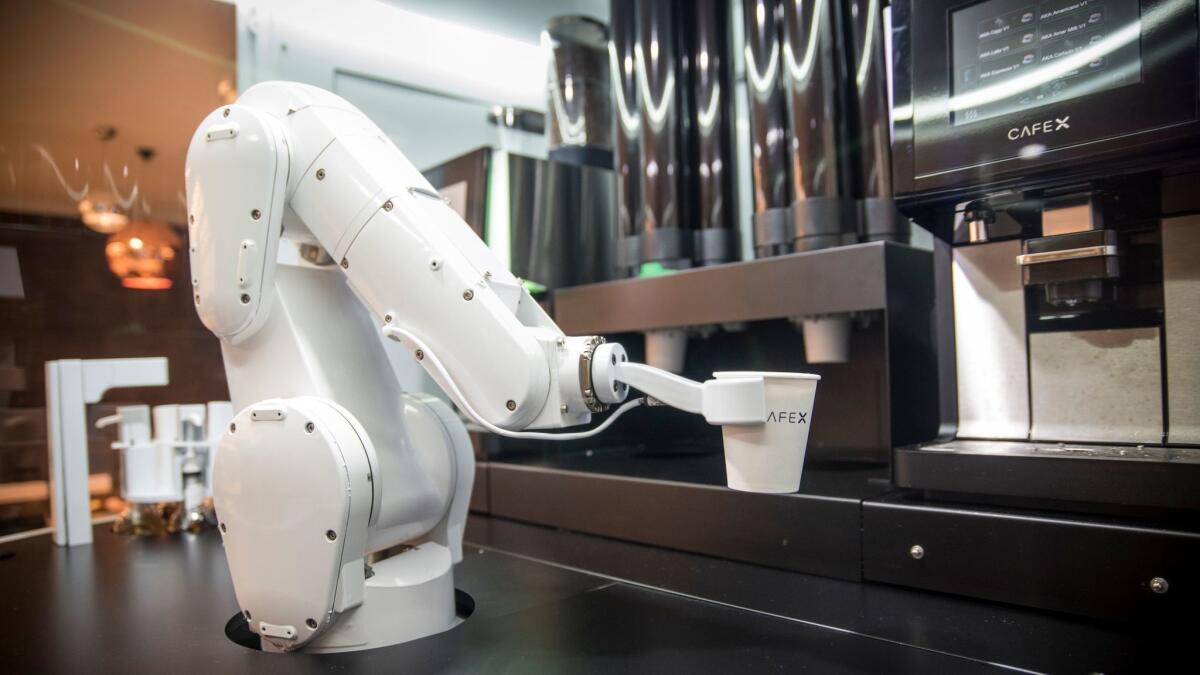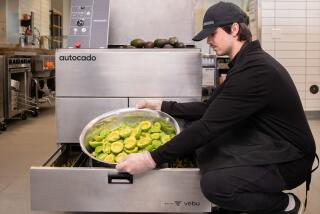San Francisco loves tech and fancy coffee. So of course it has barista robots

Reporting from San Francisco — As Katy Franco waited for her morning coffee, passersby pulled out their phones and snapped photos and video of her barista.
A man in his 20s did a double take, recorded the scene on his iPhone and posted it to Instagram. Another woman drifted toward the barista and asked no one in particular: “What’s going on here?”
Franco’s barista was a robot. It’s part of an automated coffee shop called Cafe X — the latest example of the San Francisco’s dual infatuations: artisanal coffee and automated technology.
“It’s incredibly convenient,” said Franco, who has used Cafe X twice since it opened Jan. 30. “And the coffee is really good too.”
Moments earlier, Franco had ordered her coffee using the Cafe X mobile app. Now a white robotic arm, the same kind used in car manufacturing facilities, was moving around a paper cup, pushing on syrup levers and brewing her a hot cup of coffee.
“I prefer this because you don’t have to wait,” said Franco, whose coffee was made in less than a minute. “It even accepts PayPal.”
Comments like Franco’s ring as validation to Henry Hu’s ears. Hu, a 23-year-old college dropout who founded Cafe X, envisioned his coffee kiosk as the answer to long waits at coffee shops: a well-made cup of coffee delivered quickly, efficiently and at a relatively low cost. A flat white at Cafe X is $2.95, compared with $3.75 at Starbucks — no tip required.
On the speed front, Cafe X can make a hot espresso beverage in less than a minute and is able to pump out 120 coffee drinks in an hour. A Cafe X kiosk can occupy as little as 50 square feet, although its footprint in San Francisco’s Metreon shopping mall is a little over 100 square feet and was most recently home to another automated tenant: a Bank of America ATM.
Encased in plexiglass, the kiosk contains two coffee machines equipped to brew Americanos, espressos, cappuccinos, lattes and flat whites. Customers can order their drink from the Cafe X mobile app or at one of two iPads mounted outside the kiosk. The entire transaction is cashless, and customers even get a notification on their phone when their coffee is ready.
It’s similar to calling an Uber. It’s for people who want a grab and go coffee, who want consistency.
— Henry Hu, Cafe X founder
“It’s similar to calling an Uber,” said Hu, who sees his kiosk as filling a void. “It’s for people who want a grab and go coffee, who want consistency.”
Tech investors have started dipping their toes in the food industry, backing the meal replacement start-up Soylent, the fake meat firm Impossible Foods and specialty coffee roaster Blue Bottle, among others. Cafe X is raising cash from those who seek a confluence of the familiar (technology) and the new (food).
In addition to securing a $100,000 Thiel Fellowship last year (a grant awarded by PayPal co-founder Peter Thiel’s foundation to college dropouts who want to form their own companies), Hu has raised $5 million in venture capital to expand Cafe X to more locations. His 12-person start-up built the first Cafe X kiosk in Hong Kong last year. The second kiosk — and the first in the United States — sits across from an AMC ticket counter inside the Metreon.
“People, millennials in particular, don’t want to wait in line,” said Ben Ling, an investor from Khosla Ventures, whose firm has also invested in the automated San Francisco quinoa restaurant Eatsa. “Cafe X really solves that problem of the ordering efficiency. From a user perspective, it’s vastly superior.”
Automation helps keep costs low for business owners, which in turn makes products and services more affordable for consumers, Ling said. That’s why automation — particularly in the food service and hospitality industries — seems inevitable.
Self-driving cars are already being tested on U.S. roads. Manufacturing facilities and warehouses have already automated entire professions. And while a multipurpose robot that can do everything that a waiter or chef can do is still a ways off, artificial intelligence and industrial robotics have advanced to the level where they can begin chipping away at the more menial parts of a food service job.
“Anything that has highly repetitive tasks that don’t require judgment is suitable to be automated,” Ling said.
With job loss a top issue in today’s political environment, a coffee shop that does away with baristas or a lunch spot that does away with wait staff could be a reason for outrage. But Eatsa has so far been a hit with office workers in San Francisco’s Financial District. And in its first two weeks of operation, Cafe X has drawn fast-moving lines and curious crowds who snap photos and videos of the kiosk.
In Cafe X’s defense, it isn’t fully automated. Although it doesn’t require a barista, it does need a technician to clean and restock coffee machines, one product specialist to remain on site to answer questions during operating hours, and software and hardware engineers to maintain the app and build out the kiosk. And since the entire operation relies on an Internet connection, if the Internet is down, so is the kiosk.
A much-hyped, fully automated burger joint by start-up Momentum Machines is expected to launch in San Francisco, but its founders declined to be interviewed for this story. No launch date has been announced.
Automation clearly hasn’t yet upended the food service industry, at least not when compared with the manufacturing sector, where the making of electrical and transportation equipment, machinery, and computers and appliances will account for around 75% of robotics installations over the next decade, according to research from the Boston Consulting Group.
“This is just the leading edge,” said Martin Ford, author of “Rise of the Robots: Technology and the Threat of a Jobless Future.” “The really significant thing will be when the big chains — the McDonalds, the Burger Kings, the Starbucks — begin to adopt these technologies. Eventually it is going to create a big problem for us.”
As of May 2015, the largest overall occupations in the United States, according to the Bureau of Labor Statistics, were retail salespersons (4.6 million), cashiers (3.5 million), and food preparation and service workers (3.2 million).
Technologists agree that it’s not a matter of if automation will eliminate these jobs but when. And while an argument can be made that there will always be room for services with a human touch, moves that cut costs have historically trumped those that protect jobs.
The federal government, loud in its proclamation of creating jobs, has been quiet on policies regulating and addressing the fallout from automation. And it seems consumers, for now, would rather not think about it.
“I can understand the fear of automation taking our jobs,” said Franco, clutching her robot-made coffee. “But I also work in the innovation space.”
She gestured toward her workplace, the Target Open House showroom about 100 feet from the Cafe X kiosk. The showroom was recently remodeled to better showcase the array of smart-home gadgets for sale. Inside, human employees sell Internet-enabled devices that promise to make people’s lives more efficient, connected and automated.
Twitter: @traceylien
ALSO
Take a cue from Tom Brady. Resilience on the job can pay big rewards
Zuckerberg’s goal: Remake a world Facebook helped create
Snap’s IPO builds an ‘impregnable fortress’ where only the founders have power







